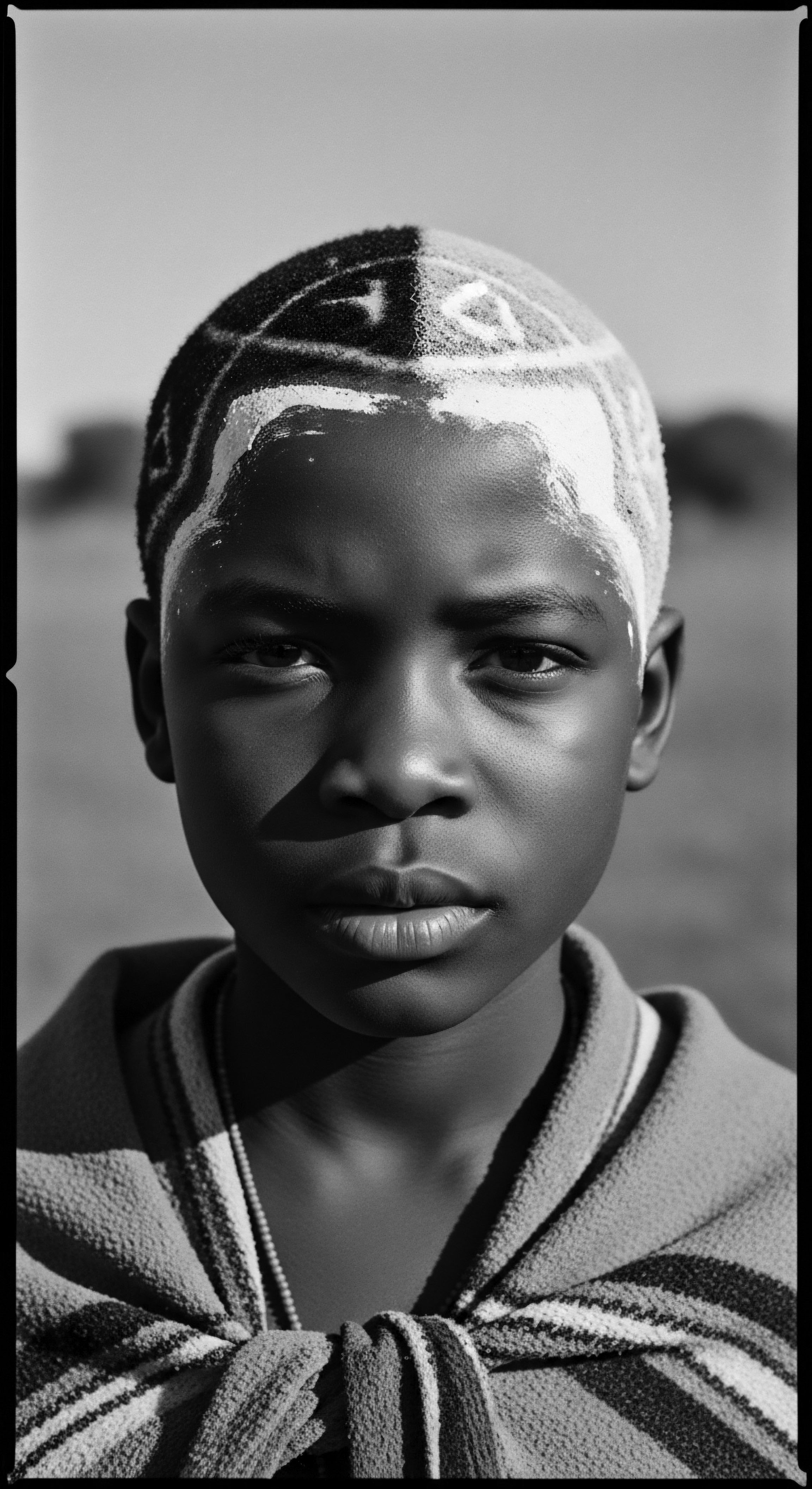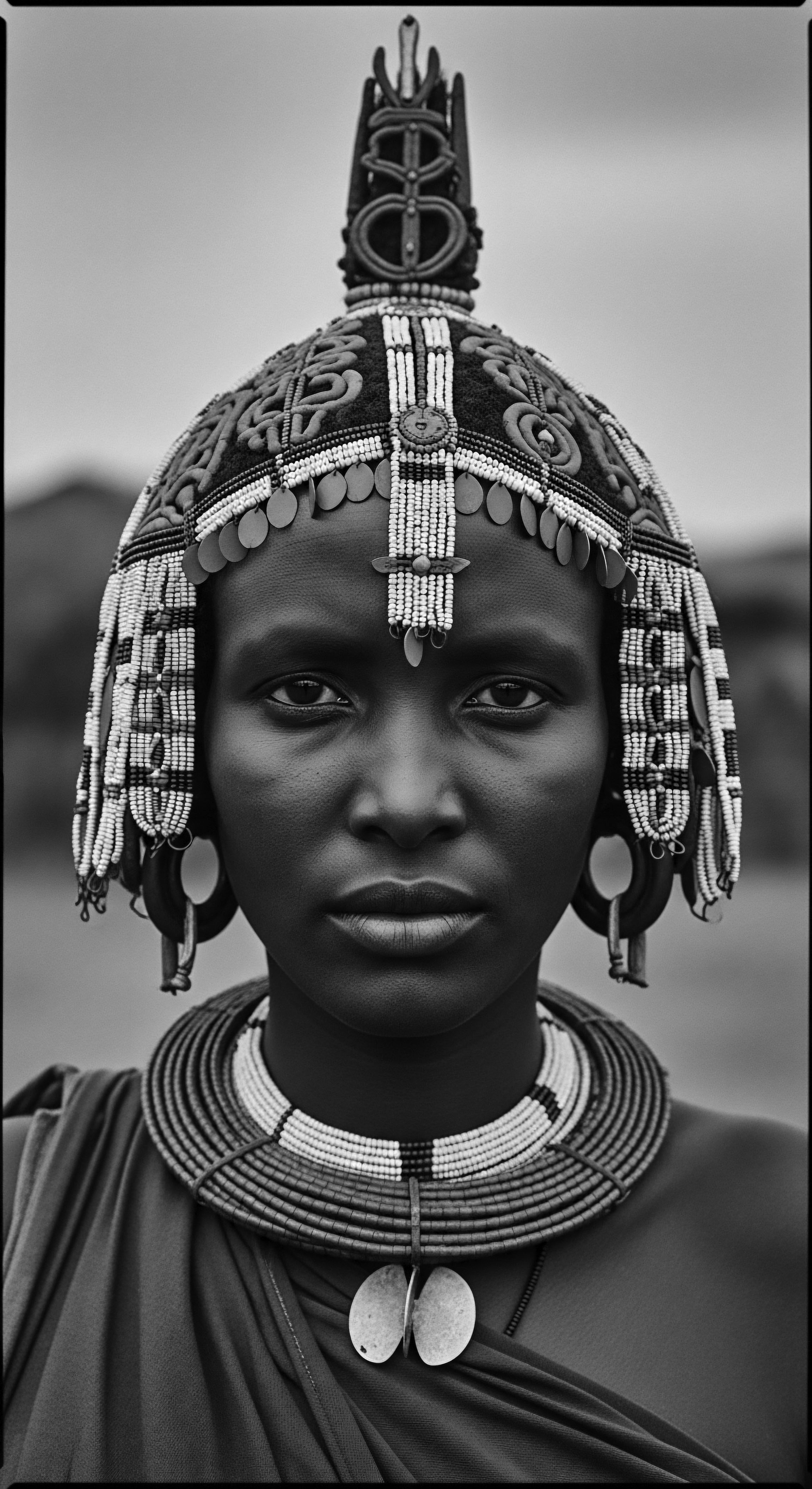
Fundamentals
The very essence of hair’s color, its rich spectrum of hues from the deepest midnight to the lightest honey, finds its genesis within specialized cells known as Melanocytes. These cellular artisans reside within the hair follicles, the tiny pockets beneath the skin from which each strand emerges, diligently producing the pigments that determine our hair’s unique shade. The term Melanocyte Depigmentation, at its fundamental core, speaks to a reduction or complete cessation of this pigment-making process within these crucial cells. This leads to a noticeable lightening or absence of color in the hair fibers.
Imagine a grand, ancient dye house, where master dyers meticulously imbue threads with vibrant colors. Each dye pot represents a melanocyte, and the color within is melanin. When a pot begins to run low on its coloring agent, or when the dyers themselves can no longer perform their task with the same vigor, the threads that pass through emerge paler, or perhaps entirely undyed. This simple explanation captures the fundamental meaning of melanocyte depigmentation within the context of our hair’s living story.

The Pigmentary Palette ❉ Melanin’s Role
The hair’s glorious spectrum is painted primarily by two types of Melanin ❉ Eumelanin and Pheomelanin. Eumelanin lends itself to darker shades, from deep black to various browns, providing robust protection against the sun’s fervent gaze. Pheomelanin, in contrast, contributes to warmer, lighter tones, appearing as red or yellow hues. The particular balance and distribution of these two pigments within each hair shaft, determined largely by our inherited ancestral codes, shape the final appearance of our tresses.
When we speak of melanocyte depigmentation, we are describing a biological shift where the consistent flow of these pigments into the hair structure diminishes. This can result in a gradual fading, a scattering of lighter strands, or in some instances, a complete transition to white hair. This transformation is a universal phenomenon, yet its appearance and cultural interpretation vary profoundly across human experiences, particularly within the rich heritage of textured hair.
Melanocyte depigmentation signifies the biological process where specialized cells within hair follicles produce less or no pigment, transforming hair’s vibrant color to lighter shades or white.

Hair Follicle’s Inner Workings
Within each hair follicle, melanocytes function within a delicate ecosystem, often referred to as the Follicular Melanin Unit. These cells, which originate from neural crest cells during embryonic development, establish themselves in the hair bulb, the base of the follicle. As hair grows, melanocytes dutifully inject melanin into the keratinocytes, the cells that form the hair shaft itself, giving the strand its characteristic coloration. This intricate process repeats with each growth cycle of the hair.
The meaning of depigmentation, therefore, is rooted in the disruption of this harmonious cellular dance. It is a natural biological event, often connected to the passage of time, reflecting shifts in the cellular environment of the hair follicle. Understanding this elemental biology forms the bedrock of our appreciation for hair’s changing complexion, especially when considered through the lens of ancestral wisdom and textured hair experiences.

Intermediate
Moving beyond the elemental definition, Melanocyte Depigmentation acquires a richer sense when we consider its pathways and the ways it shapes the living narratives of hair. This phenomenon, which represents a reduction in the pigment-producing activity of Melanocytes within the hair follicle, extends beyond simple color alteration; it touches upon the very fabric of identity and the resilience of hair traditions.

Unpacking the Mechanisms of Pigment Loss
The journey of depigmentation in hair is not singular in its unfolding. Its manifestation can arise from various underlying causes, each influencing the specific nature of the hair’s color transformation. Among these, the natural progression of age stands as a universal architect of change. As individuals advance through life, the activity and number of melanocytes within the hair follicles gradually decline.
This leads to a decrease in melanin production, resulting in the emergence of lighter strands. It is an inherent part of the human experience, a gentle marking of time upon the tresses.
However, the narrative of depigmentation encompasses conditions that are distinct from natural aging. Consider the case of Vitiligo, an autoimmune disorder where the body’s immune system mistakenly attacks and destroys melanocytes in the skin and hair. This can lead to distinct patches of white hair, a profound shift in appearance that often carries social and psychological weight within communities. Similarly, certain genetic predispositions, nutritional deficiencies, or periods of significant physiological stress can contribute to earlier or more pronounced instances of hair depigmentation.
Beyond age, melanocyte depigmentation manifests through various pathways, including autoimmune responses and genetic predispositions, each leaving a distinct imprint on hair’s color story and often impacting self-perception.

Textured Hair and the Depigmentation Story
For textured hair, particularly within Black and mixed-race communities, the manifestation of melanocyte depigmentation carries unique dimensions. While the biological process of melanin loss is universal, the way it presents on tightly coiled, kinky, or wavy strands can differ in appearance and perceived impact. The inherent structural properties of textured hair, such as its varied diameter and elliptical cross-section, can influence how light interacts with hair that has lost its pigment, sometimes lending a shimmering, almost ethereal quality to gray or white strands.
Historically, and even in contemporary times, hair has always served as a powerful visual language within these communities, speaking volumes about identity, status, and familial lineage. Therefore, changes in hair color, whether through natural graying or other forms of depigmentation, often hold deeper cultural connotations. The tender thread of care, passed down through generations, often included practices aimed at maintaining hair vitality and appearance, sometimes extending to the preservation of its original hue or the artful acceptance of its transformation.

Ancestral Perceptions and Care Practices
The wisdom of ancestral practices reveals a rich understanding of hair’s lifecycle, often predating modern scientific explanations. Many traditions from the African continent and its diaspora developed holistic approaches to hair wellness that, while not explicitly addressing “melanocyte depigmentation” in scientific terms, certainly aimed to support overall hair health and appearance. These practices frequently involved the use of natural ingredients and mindful routines.
- Botanical Infusions ❉ Ancient cultures across Africa utilized a myriad of plants, herbs, and oils—such as henna from North Africa or a variety of indigenous botanical extracts—known for their conditioning and sometimes color-enhancing properties. While henna, for instance, provides a reddish dye, its consistent use can help maintain the appearance of depth and vibrancy even as melanin levels begin to wane.
- Nutrient-Rich Applications ❉ Oils like shea butter and various plant-derived compounds, deeply embedded in ancestral hair rituals, were applied to nourish the scalp and hair strands. The significance of this nourishing touch often transcended mere aesthetics, connecting hair care to spiritual wellbeing and communal bonding.
- Protective Styling ❉ Traditional hairstyles, from intricate braids to elaborate locs, served not only as markers of identity and status but also as protective measures against environmental stressors. While not directly preventing depigmentation, such practices supported the overall health of the hair follicle, which is the very site of melanocyte activity.
The deeper comprehension of melanocyte depigmentation within this intermediate understanding underscores its connection to our inherited hair narratives. It invites us to consider how our forebears, through their empirical wisdom and intimate connection with the natural world, cultivated regimens that intuitively addressed hair’s vitality, including its pigmentation, recognizing its profound place in personal and collective identity.

Academic
The precise meaning of Melanocyte Depigmentation, within an academic context, describes a complex biological phenomenon characterized by a quantifiable reduction or complete absence of melanin synthesis and/or distribution by specialized cells known as Melanocytes within the hair follicle. These cells, derived from the neural crest, reside primarily in the hair bulb, the deepest part of the hair follicle, where they collaborate with keratinocytes to pigment the growing hair shaft. The dynamic interplay of genetic predispositions, cellular aging, and environmental stressors collectively orchestrates the intricate cascade of events leading to the manifest loss of hair color.
The delineation of melanocyte depigmentation from a scientific vantage point necessitates a precise understanding of melanosome biogenesis and transfer, the very mechanisms by which melanin is encapsulated and then ferried into the developing hair fiber. When these processes falter, either through diminished melanocyte viability, impaired melanogenic enzyme activity (such as tyrosinase), or issues in melanosome transport, the resulting hair fiber emerges without its characteristic hue. This shift from pigmented to non-pigmented hair, often observed as canities or hair graying, represents a profound physiological alteration with significant sociocultural dimensions, especially within communities where hair carries deep ancestral and identity markers.

Cellular Underpinnings of Pigment Loss
The biological architecture of hair pigmentation hinges on the vibrant activity of Melanocyte Stem Cells (MelSCs), nestled in the hair follicle bulge and secondary hair germ regions. These quiescent cells serve as a critical reservoir, differentiating into mature melanocytes that produce melanin during each hair growth cycle, known as the anagen phase. The eventual depletion or functional impairment of these MelSCs is a primary driver of age-associated hair graying.
Furthermore, the microenvironment of the hair follicle plays a non-trivial role in melanocyte survival and function. Oxidative stress, for instance, which increases with age, has been implicated in damaging melanocytes and their stem cells, thereby contributing to the decline in melanin production. The delicate balance of growth factors, signaling pathways (such as the Wnt pathway), and the availability of melanin precursors all contribute to the robust or diminished capacity of melanocytes to fulfill their pigmentary role. Disruptions in this intricate network can lead to various forms of depigmentation, from diffuse lightening to focal white patches.
| Aspect of Hair Color Change Graying Hair (Canities) |
| Traditional/Ancestral Understanding A marker of wisdom, elder status, or sometimes hardship. Often accepted as a natural progression. Rituals might involve anointing or celebratory adornment. |
| Modern Scientific Understanding Primarily due to the age-related decline in melanocyte stem cell function and subsequent reduction in melanin production; oxidative stress is a contributing factor. |
| Aspect of Hair Color Change Sudden Hair Lightening |
| Traditional/Ancestral Understanding Attributed to powerful emotional shocks, spiritual forces, or divine intervention. Specific botanical remedies for overall hair vitality. |
| Modern Scientific Understanding Can be linked to autoimmune conditions (like alopecia areata, where melanocytes are targeted) or extreme stress responses leading to rapid melanocyte loss. |
| Aspect of Hair Color Change Pigment Retention |
| Traditional/Ancestral Understanding Achieved through consistent use of nourishing plant oils, scalp massages, and protective styling, believed to maintain hair's strength and vibrancy. |
| Modern Scientific Understanding Support of follicular health through improved circulation (massage), antioxidant properties of natural ingredients, and minimizing physical stress to preserve melanocyte integrity. |
| Aspect of Hair Color Change Understanding the continuum between ancestral observations and contemporary science offers a more holistic appreciation of hair's dynamic relationship with our inner and outer worlds. |

Interconnected Incidences ❉ The Psychological Resonance of Depigmentation in Black Hair Experiences
Within the rich tapestry of Black and mixed-race hair experiences, the physical reality of melanocyte depigmentation extends far beyond the cellular. Its implications ripple through personal identity, community perceptions, and the enduring legacy of colonial beauty standards. For individuals of African descent, hair has long served as a profound repository of cultural meaning, a visual narrative of lineage, status, resistance, and self-expression. Therefore, the onset of depigmentation, particularly premature canities or conditions like vitiligo, can carry significant psychological and social weight.
Consider the compelling academic findings by Roberts (1997) in Killing the Black Body ❉ Race, Reproduction, and the Meaning of Liberty, which, while focusing broadly on the subjugation of Black bodies, inherently speaks to how control over and perceptions of Black physicality, including hair, became tools of racial oppression. This historical context illuminates the inherited anxieties surrounding hair appearance in Black communities. When hair begins to lose its pigment, especially in ways that deviate from normative aging expectations, it can disrupt an individual’s self-perception and potentially trigger an internalization of eurocentric beauty ideals that have historically devalued textured hair and celebrated straight, often lighter, hair as a standard.
Research exploring the psychosocial impacts of hair loss and changes in hair appearance among Black women offers a poignant lens through which to comprehend this intersection. A study by Goodman, et al. (2021) in the journal “Black women’s hair ❉ the main scalp dermatoses and aesthetic practices in women of African ethnicity” observes that hair holds immense cultural value for individuals of African ancestry. The article touches upon the psychosocial effects of scalp conditions, and implicitly, changes like depigmentation, noting that such concerns are common and often linked to feelings of frustration or embarrassment.
This suggests that the biological reality of depigmentation is not merely an aesthetic shift but a deeply felt experience, resonating with a collective history of hair being a site of both pride and societal scrutiny. The psychological distress associated with hair changes, including hair loss (which can be a consequence of certain depigmentation-related conditions), is well-documented, encompassing anxiety, negative self-image, and cultural disconnection.
The impact of depigmentation in textured hair thus extends into the realm of mental well-being, where societal biases about hair type and color can intersect with individual experiences of hair change. For many Black women, the pressure to conform to Eurocentric beauty standards has led to extensive use of chemical treatments, which themselves can have health implications. In this context, natural depigmentation, or even intentional coloring to a lighter shade, can become entangled in complex dialogues about authenticity, self-acceptance, and the ongoing struggle against imposed beauty norms.
The appearance of gray or white hair, once a symbol of revered elder status in some ancestral African societies, now often invites questions of youthfulness and adherence to prevailing beauty dictates. The journey of understanding melanocyte depigmentation, therefore, is also a journey into the heart of inherited identity and the profound personal fortitude required to navigate a world that often seeks to define beauty too narrowly.
To accept and celebrate the nuanced transformations brought about by melanocyte depigmentation is, for many, an act of reclaiming one’s narrative and honoring the full spectrum of hair’s ancestral journey. This acceptance fosters a deeper appreciation for the diverse manifestations of beauty and the inherent wisdom that lies within every strand, regardless of its hue.

Reflection on the Heritage of Melanocyte Depigmentation
As our exploration of Melanocyte Depigmentation draws to a close, a profound sense of reverence emerges for the intricate dance between our inner biological rhythms and the expansive heritage of textured hair. This journey, from the cellular machinery that bestows color to the cultural significance woven into every strand, illustrates that hair’s pigmentary shifts are far more than superficial alterations. They represent a living testament to time, ancestry, and the indomitable spirit of human identity.
The phenomenon of depigmentation, whether a gentle sprinkle of silver or a sudden canvas of white, beckons us to consider the echoes from ancestral sources. In countless communities across the African diaspora, the appearance of lighter strands on darker hair was not always viewed through the narrow lens of fading youth or a perceived flaw. Instead, it frequently stood as a visual chronicle of accumulated wisdom, a venerated sign of a life well-lived, deeply connected to the veneration of elders and the passing down of knowledge. These perceptions are a vital part of the enduring significance of hair’s transformation.
The meticulous care rituals, often passed through generations, were not merely cosmetic endeavors. They were acts of profound connection, holistic practices that honored the hair as a sacred extension of self and spirit. Whether through the application of plant-derived balms or the communal braiding sessions that fostered bonds, these tender threads of care intuitively nurtured the hair’s vitality, including its inherent color, or respectfully adorned its changes. The wisdom embedded in these traditions offers a powerful counter-narrative to contemporary pressures that might seek to erase the authenticity of naturally depigmented hair.
In embracing the full meaning of melanocyte depigmentation, we come to recognize the unbound helix of our identity. Our hair’s journey, with its shifts in shade, serves as a powerful medium for self-expression, a tangible link to our forebears, and a declaration of self-acceptance. It prompts a re-evaluation of beauty standards, encouraging a celebration of diversity and the inherent beauty found in every manifestation of textured hair.
The ongoing dialogue surrounding hair in Black and mixed-race communities, particularly concerning its color and texture, stands as a testament to its enduring power to voice identity and shape futures. This ongoing conversation reminds us that our hair, in all its glory and change, truly is a living, breathing archive of our collective heritage.

References
- Chen, S. & Li, R. (2022). Biology of melanocytes in mammals. Frontiers in Cell and Developmental Biology.
- Slominski, A. T. Zmijewski, M. A. & Paus, R. (2018). Skin melanocytes ❉ biology and development. Advances in Anatomy, Embryology and Cell Biology.
- Slominski, A. Wortsman, J. Tobin, D. J. Zmijewski, M. Gumprich, C. & Zbytek, B. (2005). Hair Follicle Pigmentation. Journal of Investigative Dermatology.
- Nishimura, E. K. (2011). Melanocyte stem cells ❉ a melanocyte reservoir in hair follicles for hair and skin pigmentation. Pigment Cell & Melanoma Research.
- Ghorbani, A. Hosseinzadeh, R. Alikhani, M. & Kazemi, M. (2023). Establishment and Characterization of Melanocyte Stem Cells from Hair Follicle Bulge of Vitiligo Patients. Journal of Applied Biotechnology Reports.
- StudySmarter. (2024). Melanocyte Biology ❉ Pigmentation & Function.
- NIH National Institute on Aging. (2022). The Science of Gray Hair.
- Nishimura, E. K. Granter, S. R. & Fisher, D. E. (2005). Melanocyte stem cells ❉ a melanocyte reservoir in hair follicles for hair and skin pigmentation. Cell.
- Library of Congress. (2019). Why does hair turn gray?.
- Medical News Today. (2017). Why does hair turn gray?.
- The Trichological Society. (n.d.). Hair Pigmentation Chemistry.
- Goldsmith, L. A. Katz, S. I. Gilchrest, B. A. Paller, A. S. Leffell, D. J. & Wolff, K. (2019). Pigmentation and Melanocyte Biology. Fitzpatrick’s Dermatology, 9e.
- MedlinePlus. (2022). Is hair color determined by genetics?.
- Wikipedia. (n.d.). Melanin.
- Cleveland Clinic. (2022). Melanin ❉ What Is It, Types & Benefits.
- Jackson, I. J. (2007). Melanocyte biology and skin pigmentation. Nature.
- RPGnet Forums. (2025). Real world ancient historical wild colors of hair dye?.
- Rosado, S. (2003). The symbolic grammar of hair. PhD dissertation, University of Massachusetts Amherst.
- Wikipedia. (n.d.). Henna.
- Abrams, J. Godsil, R. D. & MacFarlane, J. (2020). African American girls’ perception of skin color. Psychology of Music.
- Davies, J. & Clarke, D. (2023). “Hair is your crown and glory” – Black women’s experiences of living with alopecia and the role of social support. Journal of Health Psychology.
- Maharaj, C. (2025). Beyond the roots ❉ exploring the link between black hair and mental health. TRIYBE.
- Nyela, O. (2021). Braided Archives ❉ Black hair as a site of diasporic transindividuation (Thesis). York University.
- Johnson, A. M. & Bankhead, A. (2014). The Influence of Colorism on the Hair Experiences of African American Female Adolescents. Portland State University.
- Natural Poland. (2024). Hair Care Secrets of the Past ❉ What Our Ancestors Used for Healthy Hair.
- Johnson, A. M. & Bankhead, A. (2014). Hair It Is ❉ Examining the Experiences of Black Women with Natural Hair. Journal of Black Studies.
- Torgerson, K. (2007). Elderly Pack Behaviour ❉ An Ethnographic Study. CiteSeerX.
- D’Souza, L. & Arora, S. (2021). Hair Aging in Different Races and Ethnicities. The Journal of Clinical and Aesthetic Dermatology.
- Goodman, M. et al. (2021). Black women’s hair ❉ the main scalp dermatoses and aesthetic practices in women of African ethnicity. Anais Brasileiros de Dermatologia.
- Daniels, V. et al. (2023). “I am now being who I am and I’m proud of it” ❉ Hair related personal and social identity and subjective wellbeing of older Black women in the UK. Journal of Aesthetic Nursing.
- Gathers, R. C. & Mahan, M. G. (2015). African American Women, Hair Care, and Health Barriers. The Journal of Clinical and Aesthetic Dermatology.
- Shim, S. (2024). Our Hair ROOTS ❉ Incorporating our Black Family Hair Traditions and Routines as a Coping Technique to Increase Positive Mental Health. PsychoHairapy.
- Patterson, T. R. (2000). Unfinished Migrations ❉ Reflections on the African Diaspora and the Making of the Modern World. African Studies Review.
- Gomez, M. A. (2021). CORE-UA 532 Cultures and Contexts ❉ The African Diaspora. New York University.
- Goodman, M. et al. (2021). Black women’s hair ❉ the main scalp dermatoses and aesthetic practices in women of African ethnicity. Anais Brasileiros de Dermatologia.
- Lee, W. S. & Kim, J. M. (2012). Asian Hair ❉ A Review of Structures, Properties, and Distinctive Disorders. Journal of Clinical and Aesthetic Dermatology.
- Gilroy, P. (1993). The Black Atlantic ❉ Modernity and Double Consciousness. Harvard University Press.
- NativeMag. (2020). Examining the history and value of African hair.
- Yaseen, A. et al. (2017). Natural Colorants ❉ Historical, Processing and Sustainable Prospects. Molecules.
- Natural Poland. (2024). African Henna ❉ History, Cosmetic Uses, and Modern Applications.
- Quora. (2018). Did ancient people dye their hair and if so how did they do it?.
- Majali, A. et al. (2017). The importance of hair in the identity of Black people. Nouvelles pratiques sociales.
- Palmer, C. (2000). Rewriting the African Diaspora ❉ Beyond the Black Atlantic. Journal of Black Studies.
- Torgenson, K. (2016). ‘Hair economies’ ❉ power and ethics in an ethnographic study of African migrant women to South Africa who work in hair styling salons in Cape Town. University of Cape Town.
- Holt, T. C. (2000). African Diaspora Theory ❉ Here, There, and Everywhere. OpenEdition Books.
- Hall, J. C. (2017). No Longer Invisible ❉ Understanding the Psychosocial Impact of Skin Color Stratification in the Lives of African American Women. The Counseling Psychologist.
- Torgerson, K. (2021). Bringing Ageing to Life ❉ A Comparative Study of Age Categories. LSE Research Online.
- James-Todd, T. et al. (2011). Hair product use in African American and Latina children ❉ A pilot study. Environmental Health Perspectives.
- Daniels, V. L. & Khumalo, N. P. (2022). Space, race and identity ❉ An ethnographic study of the Black hair care and beauty landscape and Black women’s racial identity constructions in England. ResearchGate.
